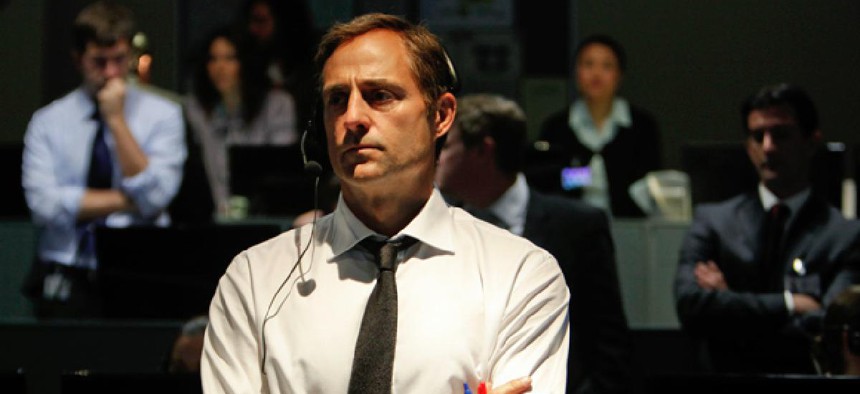Zero Dark Thirty is about more than torture
It's about the brilliant, crazy-making figures like Jessica Chastain's character who drive Washington.
Zero Dark Thirty came to Washington on Tuesday night with the kind of premiere Washington loves—canapes at the Newseum and a soupcan of controversy. Outside the screening, protesters donned hoods and orange jump suits. Inside you could see Andrea Mitchell and Mark Warner.
Folks buzzed about the torture sequences. After all, Sens. John McCain, Dianne Feinstein, and Carl Levin wrote to the head of Sony Pictures to decry the film for suggesting that enhanced interrogation techniques, as they're known, led to the location of Osama bin Laden. But for her part, director Kathryn Bigelow told the Newseum audience, “we had no agenda in making this film and were not trying to generate controversy,” which seems at best naive. Can you make a movie with this much waterboarding and not think it’ll be controversial?
The way to think about the torture in Zero Dark Thirty isn’t to dismiss it out of hand as simply a dramatization, as Motion Picture Association of America head Chris Dodd said, so don’t take it too literally. And it's also not to take Naomi Wolf’s typically overblown comparison of Bigelow to Leni Riefenstahl, the Nazi propagandist. “Handmaiden to torture,” she calls Bigelow.
So let’s sort through it. The movie clearly hypes the role of torture in hunting down bin Laden, but that needs to be qualified. It’s not presented with a Jack Bauer 24 frisson of excitement. This isn’t waterboarding porn. There’s no swelling music. It’s a grim business filmed in dank cells at dark sites from Pakistan to Poland without music or affect. Besides, all that pain isn’t always effective. As one bin Laden nephew is beaten, waterboarded, and shoved into a box the size of a small suitcase, he delivers nothing. Later, treated to hummus and sympathy, he talks.
It makes more sense to see Zero Dark Thirty’s torture as a metaphor and as the limits of film craft.
If you’re a filmmaker, it makes sense to use torture as a proxy for other aspects of the global War on Terror. You’re not going to spend zillions to realistically re-create the war in Afghanistan. It’s hard to visually depict the essential but tedious work of rolling up financial networks. Improved airline security is not going to fill seats. You want to pay $11 to see the Transportaion Security Administration?
But for those of us who think a lot about government and making it work, there’s another way to look at the film.
If you think of the War on Terror as government’s biggest project since, say, the Great Society or World War II, then it’s an even more interesting film.
Government progress is slow and messy, at once collaborative and bureaucratic. Maya (Jessica Chastain), the CIA analyst who drives the agency’s search for couriers, is the central figure in the film. But it’s worth thinking about her relationship with another CIA analyst, Jessica (Jennifer Ehle). The two seem rivals at first, each nursing her own theory of the case. They collaborate uneasily, moreso later, which is not altogether different than huge organizations like the FBI and the CIA.
A lot’s been written about Maya. The Washington Post recently ran a piece about the woman who inspired her. Also considered difficult and prickly—the kind of sexist assessment that’s more easily affixed to a woman than a man—she hasn’t even gotten a promotion to a GS-14 since bin Laden was offed.
But what hasn’t been said is that she’s the archetype of a government figure we know; the kind of driven, difficult person who drives an organization. Bigelow’s films have often had the hunters and the hunted—from Keanu Reeves's undercover police surfer chasing Patrick Swayze in Point Break to Jamie Lee Curtis after Ron Silver in Blue Steel. With skin that looks porcelain enough to shatter, Maya isn’t physically imposing. But she’s all intensity—screaming at her boss and essentially blackmailing him into giving her what she wants, living in the office, being a total pill.
There’s scant backstory about her life because her life is getting bin Laden. She’s prescient and a pain in the ass, which makes her a perfect Washington character.
We know this person. It’s Dick Cheney pushing for war in Iraq, or Dick Holbrooke pushing for peace in Bosnia, Rahm Emanuel or LBJ cursing their heads off to expand health care. Difficult people drive organizations; they can derail them, too. But the ones like Maya, whose madness is wed to a cause, are the ones who make all the difference, which is why, even if most of the action takes place in a war zone, this is a great Washington movie. If you focus just on torture, you’ll miss that.



